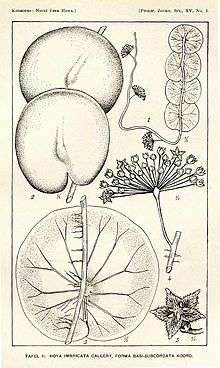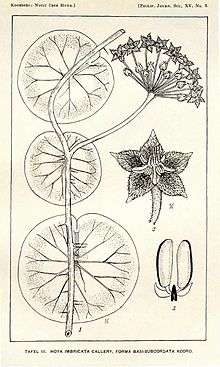Hoya imbricata
| Hoya imbricata | |
|---|---|
 | |
| Scientific classification | |
| Kingdom: | Plantae |
| (unranked): | Angiosperms |
| (unranked): | Eudicots |
| (unranked): | Asterids |
| Order: | Gentianales |
| Family: | Apocynaceae |
| Genus: | Hoya |
| Species: | H. imbricata |
| Binomial name | |
| Hoya imbricata Decne. | |

Hoya imbricata is a myrmecophile epiphytic creeper with long, thin climbing stems, occurring throughout tropical Asia. It is unusual for its large, decorative, mottled green and purple dome-shaped leaves of some 25cm in diameter, which offer accommodation to ant colonies. The succulent leaves have the appearance of waterlily pads, and are like upturned dinner plates, convex on the outer surface and concave on the inner, hugging the tree-trunk on which the plant grows, and overlapping or imbricate in the fashion of rooftiles, and providing a covered walkway from ground level into the upper branches.[1] The plant produces a network of roots beneath each leaf, exploiting nutrients resulting from the presence of the ant colony, and contributing significantly to its metabolism. As with Dischidia major an appreciable amount of carbon dioxide may be absorbed by the underside of the leaves, creating vital stocks of sugars, proteins, and lipids.
Hoya, like its myrmecophile sister genus Dischidia, belongs to the large family of Apocynaceae.
